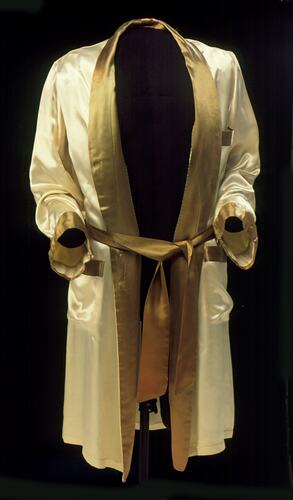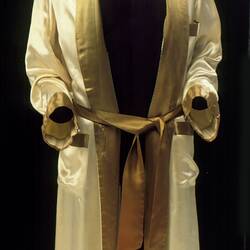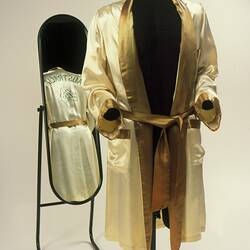Summary
Lionel Rose, a Gunditjmara man from Gippsland in Victoria, wore this gown at one of the most important boxing events of his career the World Bantamweight Championship in 1968. His career spanned from 1964 to 1975 during which time he recorded 53 wins and 11 losses.
For much of his career, Rose lived and trained at the Melbourne home of his trainer, Jack Rennie, who Rose later described as 'the best trainer probably in the world', and attributed 70 per cent of his success to him. However, at least as far as the world title fight against Harada was concerned, Rennie said Rose 'did it on his own'. A professional boxing career once offered the chance of good prize money, and perhaps even fame, when other options were limited. Throughout much of the 1900s, many Indigenous Australian boxers, including Lionel Rose's father Roy, made a living through touring 'boxing tents', with the 'tent fighters' being taken on by locals, and money bet on the outcome.
Physical Description
Cream coloured satin gown (boxing robe) with darker gold satin trim, cuffs and belt. On back of the gown in large green lettering 'AUSTRALIA' and a map of Australia containing the letters 'LR'.
Significance
Satin gown worn by Australian boxer Lionel Rose on 26 February 1968, when he went into the ring at the Budokan Stadium in Tokyo to successfully challenge Japan's Masahiko 'Fighting' Harada for the World Bantamweight Champion title. Although the fight was privately organised, the wording and map on the back of the gown clearly depict Rose as an Australian representing Australia. In a unanimous points decision, Rose won the title after a 15-round fight, which was a key event in Rose's sporting history and in the history of Indigenous boxing. Rose successfully defended the title three times before losing it to Mexican Ruben Olivares on 22 August 1969.
After winning the world title fight, Rose became a national hero with 250,000 people welcoming him home to Melbourne from Tokyo. He was only the second Australian ever to become a world champion boxer and became the 1968 Australian of the Year, the first Indigenous person to be awarded this honour. In 1968 he was awarded membership of the Order of the British Empire by Queen Elizabeth II.
More Information
-
Object/Medium
Garment
-
Locality
-
Date Produced
-
Overall Dimensions - Folded
1140 mm (Length), 650 mm (Width)
Both long sleeves folded, resting on garment.
-
User
Lionel E. Rose, Budokan Stadium, Tokyo, Kanto, Honshu, Japan, 26 Feb 1968
-
Keywords
-
Type of item
-
Discipline
-
Category
-
Collecting Areas
Australian Indigenous Identity and Contemporary Life, Australian Indigenous - South-eastern Australia, Leisure




